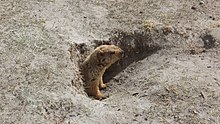Himalayan marmot
| Himalayan marmot | |
|---|---|

| |

| |
| Individual at Tshophu Lake,Bhutan(above), group with worn pelage inLadakh,India (below) | |
| Scientific classification | |
| Domain: | Eukaryota |
| Kingdom: | Animalia |
| Phylum: | Chordata |
| Class: | Mammalia |
| Order: | Rodentia |
| Family: | Sciuridae |
| Genus: | Marmota |
| Species: | M. himalayana
|
| Binomial name | |
| Marmota himalayana (Hodgson,1841)
| |
TheHimalayan marmot(Marmota himalayana) is amarmotspecies that inhabits alpine grasslands throughout theHimalayasand on theTibetan Plateau.It isIUCN Red ListedasLeast Concernbecause of its wide range and possibly large population.[1]
Taxonomy[edit]
Arctomys himalayanuswas thescientific nameproposed byBrian Houghton Hodgsonin 1841 who described marmot skins from the Himalayas.[2]In the 19th century, several Himalayan marmot specimens were described and proposed assubspecies.[3]
The Himalayan marmot is very closely related to theTarbagan marmot(M. sibirica) and somewhat more distantly to the—inmorphologyrather different—black-capped marmot(M. camtschatica). These three form aspecies groupand its nearest relative is the bobak species group, which includes thebobak marmot(M. bobak) itself, as well as thegray(M. baibacina) andforest-steppe marmots(M. kastschenkoi). In the past, the relatively short-furred and short-tailed marmots of thePalearcticregion, i.e. Himalayan, Tarbagan, gray and forest-steppe, all were regarded assubspeciesof the bobak marmot.[4]
Characteristics[edit]

The Himalayan marmot has a dense woolly fur that is rufous grey on the back and rufous yellowish on ears, belly and limbs. The bridge of its nose and end of tail is dark brown.[2]It is one of the largest marmots in the world, being about the size of a largehousecat.Average body mass ranges from 4 to 9.2 kg (8.8 to 20.3 lb), with weights lowest post-hibernation in spring and highest prior to it in autumn. In the autumn, average weight is reportedly more than 7 kg (15 lb) in both sexes. Total length is about 45 to 67 cm (18 to 26 in), with a tail length of 12 to 15 cm (4.7 to 5.9 in).[5][6][7]
Distribution and habitat[edit]

The Himalayan marmot occurs in theHimalayasandTibetan Plateauat altitudes of 3,000 to 5,500 m (9,800–18,000 ft) in northeastern Pakistan, northern India,Nepal,Bhutanand China.[4][8]In China, it has been recorded inXin gian g,Qinghai,Gansu,Xizang,westernSichuanandYunnanprovinces.[9]In the west its distribution reaches that of thelong-tailed marmot(M. caudata), but the two are not known tohybridize.The Himalayan marmot lives in short grass steppes oralpinehabitats, typically above thetree linebut below the permanent snow limit.[4]
Ecology and behaviour[edit]

The Himalayan marmot lives incoloniesand excavates deep burrows that colony members share duringhibernation.[8]The species hibernates from the late autumn to the early spring, on average for 71⁄2months.[4]Burrows are between 2 and 10 m (6.6–32.8 ft) deep, given that the upper soil layer is sufficiently light and deep such asfluvioglacial,deluvialandalluvial deposits.Where soil conditions are ideal on alluvial terraces, marmot colonies comprise up to 30 families, with up to 10 families living in an area of 1 km (0.6 mi). The marmot eats plants growing on pastures, in particular the soft and juicy parts of grassy plant species likeCarex,Agrostis,Deschampsia,Koeleriaand flowering species likeEuphrasia,Gentiana,Halenia,Polygonum,Primula,Ranunculus,Saussurea,TaraxacumIris potaninii.[5]
Reproduction[edit]
Females become sexually mature at the age of two years. After one month ofgestationthey give birth to litters of two to 11 young.[8]
Predators[edit]
On theTibetan plateau,marmot species form part ofsnow leopardprey.[10]Other predators of Himalayan marmots includeTibetan wolves,red fox,and large birds of prey likehawks,kestrels,bearded vultures,andgolden eagles.[11][12]
In culture[edit]
It was known to theancient Greekwriters as thegold-digging antapparently as reference to the fact thatgold nuggetswere found in the silts of the burrows these marmots dug.[13][14]TheFrenchethnologistMichel Peisselclaimed that the story of'gold-digging ants'reported by the GreekhistorianHerodotuswas founded on the golden Himalayan marmot of theDeosai plateauand the habit of local tribes such as theMinaroto collect thegolddust excavated from their burrows.[15]
A photograph of a Himalayan marmot under attack by aTibetan foxtaken byBao Yongqingwon the overall prize in the 2019Wildlife Photographer of the Yearaward.[16]
See also[edit]
References[edit]
- ^abShrestha, T. (2017) [errata version of 2016 assessment]."Marmota himalayana".IUCN Red List of Threatened Species.2016:e.T12826A115106426.
- ^abHodgson, B. H. (1841)."Notice of the Marmot of the Himalaya and of Tibet".The Journal of the Asiatic Society of Bengal.10(2): 777–778.
- ^Thorington, R.W. Jr; Hoffman, R.S. (2005)."SpeciesMarmota (Marmota) himalayana".InWilson, D.E.;Reeder, D.M (eds.).Mammal Species of the World: A Taxonomic and Geographic Reference(3rd ed.). Johns Hopkins University Press. p. 801.ISBN978-0-8018-8221-0.OCLC62265494.
- ^abcdKryštufek, B.; Vohralík, B. (2013). "Taxonomic revision of the Palaearctic rodents (Rodentia). Part 2. Sciuridae: Urocitellus, Marmota and Sciurotamias".Lynx, N. S. (Praha).44:27–138.
- ^abNikol’skii, A. A.; Ulak, A. (2006). "Key factors determining the ecological niche of the Himalayan marmot,Marmota himalayanaHodgson (1841) ".Russian Journal of Ecology.37(1): 46–52.Bibcode:2006RuJEc..37...46N.doi:10.1134/S1067413606010085.S2CID23526958.
- ^Chaudhary, V.; Tripathi, R. S.; Singh, S.; Raghuvanshi, M. S. (2017)."Distribution and population of Himalayan MarmotMarmota himalayana(Hodgson, 1841) (Mammalia: Rodentia: Sciuridae) in Leh-Ladakh, Jammu & Kashmir, India ".Journal of Threatened Taxa.9(11): 10886–10891.doi:10.11609/jott.3336.9.11.10886-10891.
- ^Duff, A.; Lawson, A. (2004).Mammals of the World: A Checklist.Yale University Press. p. 38.ISBN978-0-300-10398-4.Retrieved2024-05-13.
- ^abcMolur, S.; Srinivasulu, C.; Srinivasulu, B.; Walker, S.; Nameer, P.O.; Ravikumar, L. (2005).Status of non-volant small mammals: Conservation Assessment and Management Plan (C.A.M.P) workshop report.Coimbatore, India: Zoo Outreach Organisation / CBSG-South Asia.
- ^Smith, A.T.; Xie, Y. (2008).A Guide to the Mammals of China.Princeton, New Jersey: Princeton University Press.
- ^Lyngdoh, S.; Shrotriya, S.; Goyal, S. P.; Clements, H.; Hayward, M. W. & Habib, B. (2014)."Prey preferences of the snow leopard (Panthera uncia): regional diet specificity holds global significance for conservation ".PLOS ONE.9(2): e88349.Bibcode:2014PLoSO...988349L.doi:10.1371/journal.pone.0088349.PMC3922817.PMID24533080.
- ^Padgett, L.; Small, C. (2011)."Marmota himalayana, Himalayan marmot".Animal Diversity Web.Archivedfrom the original on 6 September 2019.Retrieved2 August2020.
- ^Rajat Ghai (7 July 2020)."After bats, do not make marmots into villains: Expert".Down To Earth.Archivedfrom the original on 2 August 2020.Retrieved2 August2020.
- ^Simons, Marlise (25 November 1996)."Himalayas offer clue to legend of gold digging 'ants'".New York Times.Archived fromthe originalon 2016-04-14 – via livius.org.
- ^N. Shiva Kumar (September 22, 2013)."Marmots caught off guard".The Hindu.Archivedfrom the original on November 29, 2014.RetrievedMay 7,2016.
- ^Peissel, M. (1984). "The Ants' Gold: The Discovery of the Greek El Dorado in the Himalayas". Harvill Press.ISBN978-0-00-272514-9.
- ^"Wildlife photographer of the year 2019 winners – in pictures".The Guardian.2019-10-16.Archivedfrom the original on 2019-10-16.Retrieved16 October2019.

